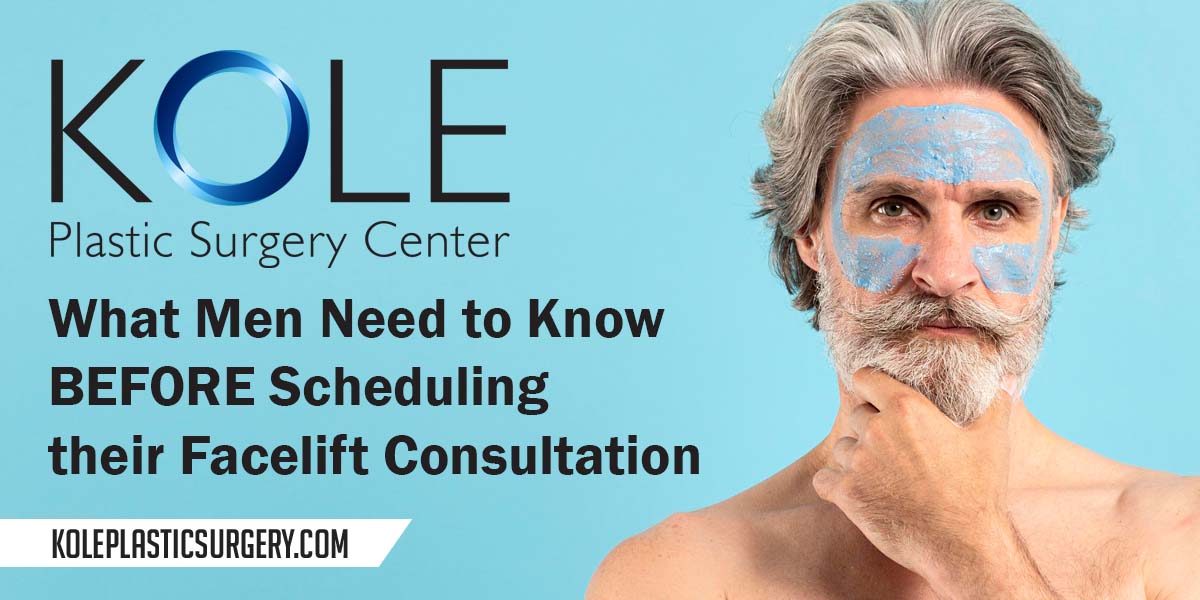[vc_row][vc_column][vc_column_text]Statistics are proving over recent years that men are getting plastic surgeryin increasingly rising numbers. The taboo of men getting procedures or “work done” no longer exists. They are now getting procedures to better their health and to boost their confidence.
This shows there is a need for more detailed and quality information about male-focused procedures and how they can differ from female-specific plastic and cosmetic procedures.
That is why Dr. Edward S. Kole of The Kole Plastic Surgery Center has assembled this information to help the growing numbers of male patients interested in cosmetic and plastic surgery procedures be more prepared for their pre-procedure consultations.
Without a doubt, there are questions that should always be asked during a consultation that will be standard. These tend to be gender-neutral. Then there are special considerations that should be discussed that pertain to both the individual and the male-adapted surgical procedure. In this article, we focus on what all men need to know before their consultation for a male facelift.
Get Your Cosmetic Surgery Goals in Mind
During any consultation, your plastic surgeon will ask what you hope to get out of the surgery. You should have an idea in your mind what you want to change, what you want to keep, and what a successful surgery would mean to you. Facelift procedures generally pull the skin tighter to reduce wrinkling and sagging, but the areas of concentration will depend on personal preference and gender.
Generally, female facelifts focus more on the eyes, nose, and mouth area, while male facelifts focus on the brow, jawline, jowls, and cheeks. Remember, each surgery is unique to the patient, so think about what problem areas you want to be fixed by the surgery before your consultation so you are able to describe to your surgeon what you hope to get out of the procedure.
Ask Questions About YOUR Plastic Surgery
Once you describe what it is you hope to get out of your facelift, Dr. Kole will talk to you about the procedure itself and how your goals might be obtained. It is important to ask questions during this process to connect your goals with what will actually occur during surgery.
How will you correct this skin under my jaw? Will these wrinkles around my eyes disappear? Can you make my cheeks look full again? These are all questions to keep in mind! Like any procedure, it is necessary to be realistic and know what a facelift can and cannot do for you. The best way to figure out what can be done is by asking your doctor questions about the procedure and how he plans on addressing your complaints about the way you currently look.
Consider Potential Scarring from Your Facelift
Women have an advantage over men when it comes to post-facelift scarring. They have more hair and men tend to have less hair to hide their scars. Generally, the age of most men coming for facelifts is between the ages of 45-75, an age that for many men means thinning, hairless, and balding.
If this is the case, it is especially important for you to ask about suture placement and scarring. Facelift surgery leaves small scars where incisions are made, and although they are tiny, they are not invisible. Sutures are generally placed in front of and behind the ears, under the chin, and close to the hairline. If you have a receding hairline or are bald, however, there may not be a way to hide scarring.
Ask Dr. Kole to see pictures of other male facelifts they had performed, and check to see where scars appear. Do these men have hair? Are scars hidden by natural creases? Again, the more you know about how the procedure is performed, the better idea you will have about what is realistic to expect from your facelift.
It Is Never Too Early To Think About Post Facelift Recovery
It might seem unnecessary to ask about what to expect during recovery if you have not yet decided on the procedure, but this should be part of your consultation appointment. Men tend to be less patient when it comes to recovery periods, which can be a result of responsibilities at work, attempts to hide the surgery, or they could be just plain restless. Whatever the reason for the desire to rush the recovery process, it is imperative that men know what to expect so they can prepare to recover from your male facelift appropriately.
Men also need to take into consideration certain aspects that women don’t, such as shaving their faces and trimming their hair and sideburns. During recovery, men need to pay particular attention to their sutures and should be careful not to damage them, so shaving and hair-trimming are not encouraged for the first week or so.
To discuss your male facelift concerns, or for questions on other male plastic surgery procedures, and to schedule a complimentary private consultation with Dr. Kole, please call the office at 215-315-7655. Our office and Licensed Ambulatory Surgical Center is conveniently located at: 1122 Street Rd Southampton, PA 18966.[/vc_column_text][/vc_column][/vc_row]






